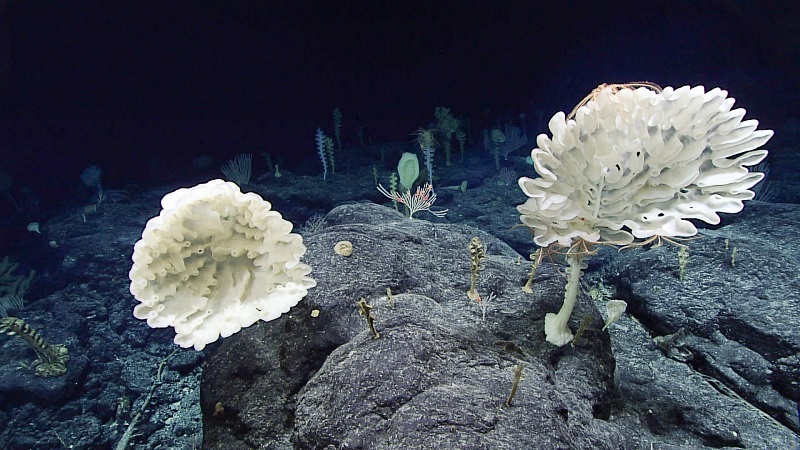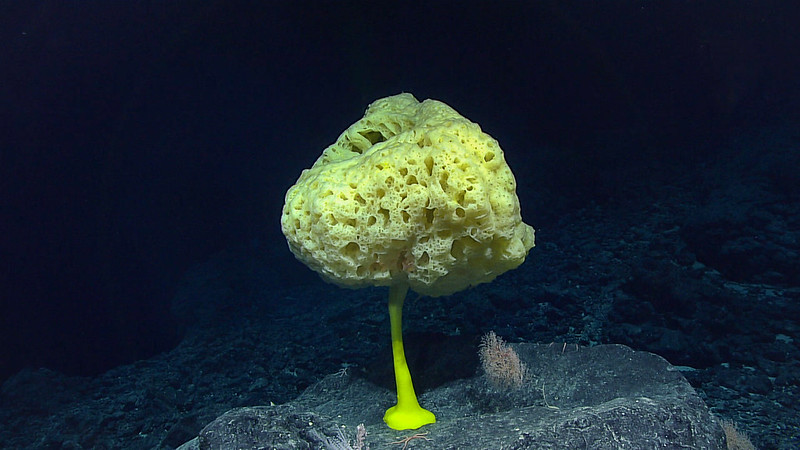“This is like a battery in a rock,” Gerard Barron, CEO of The Metals Company, formerly known as Deep Green, told an investment journalist during a mining conference in Cape Town in 2019.
In his right hand, he held up to the camera a black mineral concretion about the size of a potato, known as a polymetallic nodule.
Found on the deep sea floor, these nodules are rich in nickel, cobalt, copper and manganese: minerals critical for manufacturing electric vehicles.
The Australian entrepreneur, who cast himself as the face of the nascent deep sea mining industry, has pitched these nodules as the only sustainable option to meet the world’s electrification needs.
His company argues that “the world’s largest estimated source of battery metals” lies untouched on the ocean’s floor – enough to electrify 280 million vehicles.
“Whether you invest in a company like DeepGreen or not, everyone is a sucker for the story,” Barron said.
Three years on, the story Barron has to tell is one of struggle, verging on collapse. His company, which triggered a rush to open the deep seabed to mining, is in dire straits. Its share price is sinking, funds are dwindling and it’s embroiled in multiple lawsuits against investors.
The Metal Company’s (TMC’s) survival is staked on receiving a green light from the international regulator to mine the ocean’s deep. As the company flounders, the pressure on nations to agree mining rules hasn’t eased and other prospectors are waiting in the wings.
Did you know that #Polymetallic nodules sitting on top of the seabed are made of almost 100% usable minerals? These nodules are from the latest collection on our current #DeepGreenExpeditions pic.twitter.com/699vV80Ydw
— gerard barron (@gtbgtb) December 16, 2019
Countries have been discussing mining the bottom of the oceans for years. While some exploratory activities are under way, no commercial extraction has started in international waters.
Scientists have warned that far too little is known about the deep ocean, its biodiversity and the role it plays in storing carbon to allow companies to mine the seabed. Mining would result in biodiversity loss “that would be irreversible on multi-generational timescales,” they say. Calls for a ban on the practice are growing.
In many ways, Barron has put the spotlight on the frontier mining sector. He was a major investor of Nautilus Minerals, which aimed to carry out the world’s first commercial deep sea mining around hydrothermal vents off the coast of Papua New Guinea. Barron pulled out before the company went bust.
As CEO of Vancouver-based TMC, Barron continued to argue that deep sea nodules were a more scalable and sustainable option than mining battery minerals on land.
His public interventions drew attention to the International Seabed Authority (ISA), the UN body which regulates mining activities in international waters which, until then, had operated under little scrutiny.
TMC had one objective: accelerating the approval of a mining code for the deep seas.
The company struck deals with Nauru, Tonga and Kiribati to explore an area of the Pacific Ocean known as the Clarion Clipperton Zone, where a high concentration of nodules has been found.
In 2021, Nauru, a vocal supporter of the emerging industry, triggered a never-before-used procedure giving the ISA two years, until July 2023, to fast-track deep sea mining exploitation rules. If the rules aren’t finalised by July 2023, the ISA will have to “consider and provisionally approve” licencing requests regardless.
The ultimatum allows Nauru Ocean Resources Incorporated (Nori), a TMC subsidiary sponsored by the Nauru government, to apply for a mining permit as soon as next year.
It sent the ISA into overdrive. But as the ISA council is meeting this month, in Kingston, Jamaica, to progress the rules, it is uncertain that TMC will have the financial backing to take advantage of the resulting opportunities.
TMC listed on the Nasdaq stock exchange in New York in September 2021 gambling that it could start mining the deep sea in 2024.
Things got off to a bad start. Two large investors withheld $220m of promised investment. TMC is suing the investors to recuperate the money.
A month later, a shareholder filed a class action against TMC and its CEO Barron. It accused the company of making “materially false and misleading statements” and having failed to disclose information about its operations.
The allegations include that TMC “significantly overpaid… undisclosed insiders” for the acquisition of an exploration permit for its Tonga-sponsored company.
The plaintiff claims that the company “artificially inflated” the expenditures of its subsidiary in Nauru ”to give investors a false scale of its operations” and “significantly downplayed the environmental risks”. They added that TMC “would not have the cash necessary for large scale production”.
A second shareholder case with the same allegations was filed and the two suits are being addressed together.
The allegations were made based on a report by market research firm Bonitas Research. It alleges that TMC siphoned $43m in cash during its acquisition of its Tonga subsidiary.
TMC denied all allegations of wrongdoing and is defending itself in court. But it did clarify to investors the risks associated with the enterprise.
In its recent filing to the US Securities and Exchange Commission (SEC), TMC details 25 risks to investors buying into the company, taking up 24 pages of the 179-page document.
Among them: environmental liabilities, the absence of guarantees that the nodules will be suitable for commercialisation, the risk of having overestimated the quality and quantity of nodules, the negative reputation the industry is gaining and the company’s lack of funds.

Farreid glass sponges found at about 2,360 meters deep pictured at the Pacific Remote Islands Marine National Monument (Photo: NOAA Office of Ocean Exploration and Research)
This hasn’t contributed to investor confidence.
Earlier this month, the United Nations Environment Programme Finance Initiative published a briefing paper arguing that the practice cannot be considered sustainable and that investors should avoid the industry.
TMC’s share price collapsed from a high of $12 at its launch last September to less than a $1 since the start of July.
Under Nasdaq rules, if the share price doesn’t rebound above $1 for 30 consecutive days, the company faces delisting – a significant reputational blow to the company.
“There is not a lot of confidence in the marketplace that TMC can deliver what it has hyped it can do. Investors are not buying it,” Matthew Gianni, co-founder of the Deep Sea Conservation Coalition, told Climate Home.
Analysis: As Xi Jinping seeks more power, the world’s window into China’s climate action narrows
Last months’ filing with the SEC shows that as of March 2022, TMC had $69m in cash in the bank. In 2021, the company estimated it needed $7bn for large-scale production.
TMC recognises that “failure to obtain additional financing on a timely basis could cause us to reduce or terminate our operations”.
For Duncan Currie, a legal advisor to the Deep Sea Conservation Coalition, the firm’s dwindling funds pose another issue.
“The company is obviously undercapitalised. If there is environmental damage, who will end up paying for that?” he asked.
The ISA is discussing a proposal for a compensation fund to address damages to the marine environment which would be funded from the proceeds of mining. “But that means there will be no money in the fund on the first day of mining and that is when damage is likely to be caused,” said Currie.
Rolling in the deep! Allseas engineers have successfully driven the pilot nodule collector across the seafloor at depths of ~2,500m, bringing us ever closer to responsibly unlocking the world’s largest undeveloped source of battery metals.
Learn more: https://t.co/ush2xTeaDj pic.twitter.com/fqG0RMBybG
— The Metals Company (@themetalsco) May 5, 2022
Publicly, TMC remains bullish about its financial situation. The money in its account “will be sufficient to meet our working capital and capital expenditure requirements for at least the next twelve months from today,” it said about its quarterly results.
It added that it was still testing its nodule collection system and exploring a potential processing plant in India.
But the management has been avoiding tough questions. Its online annual general meeting at the end of May lasted a mere 13 minutes. A question about when the company’s cash might run out was ignored.
Andy Whitmore, finance advocacy officer at the Deep Sea Mining Campaign, told Climate Home the company is “running out of money” and is “closer than they admit” to bankruptcy.
“They have an ambitious plan, which requires moving forward at speed” to start mining, he said. But “the loss of share value both indicates that investors are not sure about this, and also makes their position more precarious.”
“It’s sort of like the Wizard of Oz, you have to look behind the curtain,” said Catherine Coumans, of MiningWatch Canada.
Coumans said CEO Barron, had cast himself as “the hipster dude who is going to save the world with this cool new thing” and put himself forward as “poster boy” for the frontier industry.
As a result, TMC’s fate could reflect badly on the nascent sector, she said.

A yellow glass sponge observed at a depth of 2.5km in the Sibelius Seamount in the Pacific (Photo: NOAA Ocean Exploration/Flickr)
But public attention has highlighted its potential as a lucrative industry. An MIT cost-benefit analysis found that mining nodules could generate annual revenues of $2.3bn a year.
“It’s like getting between the wolf and its food,” Coumans told Climate Home. “One company may go down but another will come back.”
Belgian company Global Sea Mineral Resources (GSR), which is sponsored by Belgium and the Cook Islands, is already testing technology to collect nodules from the sea floor 4.5 kilometres beneath the surface.
The UK Seabed Resources, a subsidiary of the US arms conglomerate Lockheed Martin sponsored by Britain, is another frontrunner in the field.
“There’s a whole bunch of big companies that have very deep pockets and the patience to wait this one out,” said Coumans. “They don’t want to rock the boat and would have perhaps preferred [for the issue] to be way more under the radar than it’s become.”
Fiji has banned deep sea mining in this Decade of #OceanScience because we’ve chosen discovery over destruction.
We know more about the moon’s surface than the deep seabed. Until we learn more, short-term profits can’t win out over priceless ocean-based knowledge.
— Frank Bainimarama (@FijiPM) October 5, 2021
While the industry is gearing up for mining to start in the next few years, a growing number of countries have expressed reservations about opening up the world’s most remote ecosystem to mining.
During a UN conference on the Oceans in Portugal last month, Palau and Fiji launched an alliance of countries calling for a moratorium on deep sea mining endorsed by Samoa, Tuvalu, Solomon Islands and the Federal States of Micronesia.
French president Emmanuel Macron called for the creation of “the legal framework to stop the high-sea mining and not to allow new activities putting in danger these ecosystems”. While France sponsors two exploration contracts, these activities should remain “pure scientific missions,” he said.
More than 210 lawmakers from 47 countries have joined a parliamentarian alliance supporting a ban.
And recently, the EU Commission said it intended to “prohibit deep-sea mining” until scientific gaps are filled and show it can be done without harmful effects.
Gianni said despite signs that a large number of nations are not ready to allow deep sea mining from next year, how this translates in the technical negotiations remain unclear.
“If mining starts, it will prove nearly impossible to rein it in,” he said.
The Metals Company did not respond to Climate Home’s request for comment.
